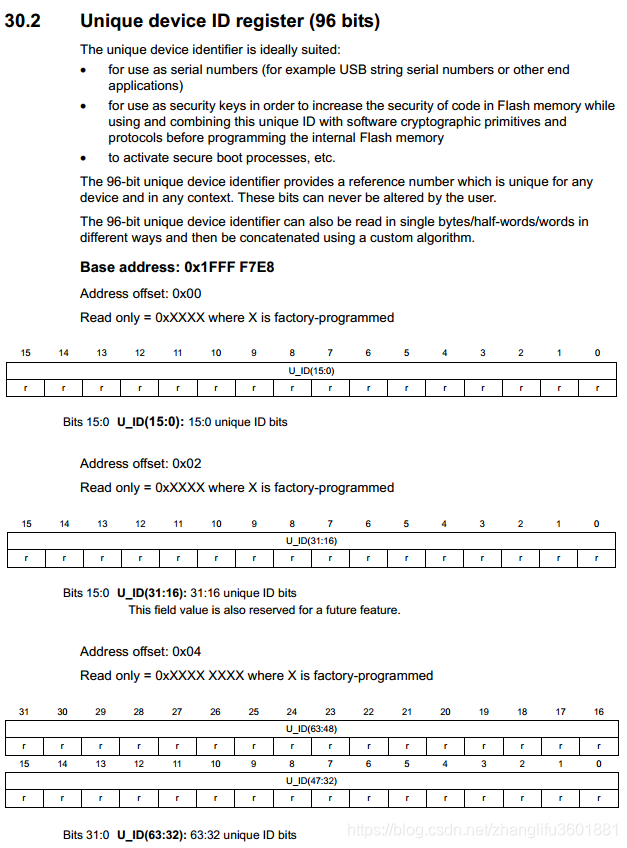一、简介
在嵌入式设备开发过程中有时会需要为设备设置唯一的ID用以标识设备唯一,比如要求同一总线上的所有设备ID不能重复,要求设备具体唯一的MAC地址等等。每个STM32微控制器都自带一个96位的唯一ID,这个ID在任何情况下都是唯一且不允许修改的,这96位的ID可以以字节(8位)为单位读取,也可以以半字(16位)或全字(32位)读取。不同型号的STM32芯片首地址不同,UID首地址也不同。
在ST的相关资料中,对其功能的描述有3各方面:
- 用作序列号(例如 USB 字符串序列号或其它终端应用程序)
- 在对内部 Flash 进行编程前将唯一 ID 与软件加密原语和协议结合使用时用作安全密钥以提高 Flash 中代码的安全性
- 激活安全自举过程等

由上图可知,在STM32F1xx的数据手册中关于UID的描述有(从0x1FFFF7E8地址开始的12个字节96bit)
在不同系列的MCU中地址是有差别的,如下图:

二、获取芯片UID
uint32_t GetUid(uint8_t* pUid)
{
uint32_t chipId[3] = {
0};
//获取CPU唯一ID
#if 0//STM32F1系列
chipId[0] =*(volatile unsigned long *)(0x1ffff7e8); //按全字(32位)读取
chipId[1] =*(volatile unsigned long *)(0x1ffff7ec);
chipId[2] =*(volatile unsigned long *)(0x1ffff7f0);
#endif
#if 1//STM32F4系列
chipId[0]=*(volatile unsigned long *)(0x1fff7a10);
chipId[1]=*(volatile unsigned long *)(0x1fff7a14);
chipId[2]=*(volatile unsigned long *)(0x1fff7a18);
// /* printf the chipid */
// printf("\r\n芯片的唯一ID为: %X-%X-%X\r\n",
// chipId[0],chipId[1],chipId[2]);
// printf("\r\n芯片flash的容量为: %dK \r\n", *(uint16_t *)(0X1FFF7a22));
#endif
//按字节(8位)读取
pUid[0] = (uint8_t)(chipId[0] & 0x000000FF);
pUid[1] = (uint8_t)((chipId[0] & 0xFF00) >>8);
pUid[2] = (uint8_t)((chipId[0] & 0xFF0000) >>16);
pUid[3] = (uint8_t)((chipId[0] & 0xFF000000) >>24);
pUid[4] = (uint8_t)(chipId[1] & 0xFF);
pUid[5] = (uint8_t)((chipId[1] & 0xFF00) >>8);
pUid[6] = (uint8_t)((chipId[1] & 0xFF0000) >>16);
pUid[7] = (uint8_t)((chipId[1] & 0xFF000000) >>24);
pUid[8] = (uint8_t)(chipId[2] & 0xFF);
pUid[9] = (uint8_t)((chipId[2] & 0xFF00) >>8);
pUid[10] = (uint8_t)((chipId[2] & 0xFF0000) >>16);
pUid[11] = (uint8_t)((chipId[2] & 0xFF000000) >>24);
return (chipId[0]>>1)+(chipId[1]>>2)+(chipId[2]>>3);
}
uint8_t uid[12] = {
0};
GetUid(uid);
for(uint8_t i = 0; i < 12; i++)
{
printf("%02x", uid[i]);
}
三、获取MAC地址
/**
@brief 获取MAC地址
@param pMac - [out] MAC地址
@return 无
*/
void GetMacAddress(uint8_t *pMac)
{
uint32_t uid = 0;
uint8_t chipId[15] = {
0};
int i = 0;
mcuId = GetChipId(chipId);
for(i = 0; i < 12; i++) // 获取ID[12]
{
chipId[12] += chipId[i];
}
for(i=0; i<12; i++) // 获取ID[13]
{
chipId[13] ^= chipId[i];
}
pMac[0] = (uint8_t)(uid & 0xF0);
pMac[1] = (uint8_t)((uid & 0xFF00) >> 8);
pMac[2] = (uint8_t)((uid & 0xFF0000) >> 16);
pMac[3] = (uint8_t)((uid & 0xFF000000) >> 24);
pMac[4] = chipId[12];
pMac[5] = chipId[13];
}
uint8_t mac[6] = {
0};
GetMacAddress(mac);
for(uint8_t i = 0; i < 6; i++)
{
printf("%02x", mac[i]);
}
虽然这个96位的ID是唯一的,但是MAC地址却只有48位,因为量产有不同批次,而且采购的很随机的话这个ID号也是不唯一的,比较靠谱一点的还是自己在指定FLASH位置定义一个变量,这样程序就写死去读这个地方的值,而这个地方的值我们再用别的方式去修改,如自己写个上位机用串口通信设置等。
MAC地址的前12bit固定,后面的便可以直接如此自定义设置。
/**
@brief 获取MAC地址
@param pMac - [out] MAC地址
@return 无
*/
void GetMacAddress(uint8_t *pMac)
{
pMac[0] = 0x11;
pMac[1] = 0x22;
pMac[2] = *(volatile uint8_t *)(0X800F000);
pMac[3] = *(volatile uint8_t *)(0X800F001);
pMac[4] = *(volatile uint8_t *)(0X800F002);
pMac[5] = *(volatile uint8_t *)(0X800F003);
}
使用了正点原子的脱机下载器,注释掉该定义变量,并在该处设置滚码。


• 由 Leung 写于 2022 年 7 月 29 日
• 参考:STM32 进阶教程 9 - 芯片维一码(UID)读取
如何获取STM32 MCU的唯一ID
读取STM32芯片的唯一ID和MAC地址
stm32设置唯一MAC地址